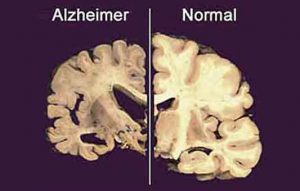
Cervello con l’Alzheimer
Alzheimer’s disease: the process that destroys the brain involves two proteins called beta-amyloid and tau detected by two blood tests.
Beta-amyloid clumps into plaques, which slowly build up between brain cells.
Abnormal tau accumulates inside brain cells, forming tangles.
PET scans of the brain and lab tests of spinal fluid can reveal disease-related changes, or pathology, twenty years before the onset of symptoms, but a blood-based screening test would identify people who have started down the path toward Alzheimer’s years before they could be diagnosed based on symptoms.
However, PET imaging is expensive and involves radioactive agents, and spinal fluid tests are invasive, complex, and time-consuming.
Researchers are looking for simpler, more cost-effective tests: a blood test would be cheaper and less invasive than PET scans or spinal taps.
Amyloid beta blood test
“Our results demonstrate that this amyloid beta blood test can detect if amyloid has begun accumulating in the brain,” said Randall J. Bateman, MD, the Charles F. and Joanne Knight Distinguished Professor of Neurology and the study’s senior author.
“This is exciting because it could be the basis for a rapid and inexpensive blood screening test to identify people at high risk of developing Alzheimer’s disease.”
As the brain engages in daily tasks, it continually produces and clears away amyloid beta.
Some is washed into the blood, and some floats in the cerebrospinal fluid, for example.
If amyloid starts building up, though, it can collect into plaques that stick to neurons, triggering neurological damage.
(link…https://www.mybestlife.com/health/News-2017-Jul/20170726-Alzheimer-blood-test.html)
Tau blood test
A team led by Dr. Adam Boxer at the University of California, San Francisco investigated whether a new blood testing technique called Simoa could be used to measure the concentrations of tau and predict development of Alzheimer’s disease.
The study was funded in part by NIH’s National Institute on Aging (NIA), National Institute of Neurological Disorders and Stroke (NINDS), and National Center for Advancing Translational Sciences (NCATS). Results were published online on March 2, 2020, in Nature Medicine.
The team collected blood samples from more than 400 people. They measured the concentration of ptau181—a modified version of tau that’s been linked with Alzheimer’s disease—in blood plasma, the liquid part of blood.
Their analysis showed that the ptau181 in plasma differed between healthy participants and those with Alzheimer’s pathology confirmed in autopsies.
The test could also differentiate Alzheimer’s pathology from a group of rare neurodegenerative diseases known collectively as frontotemporal lobar degeneration.
The results with the plasma ptau181 test also mirrored results with two established biomarker tests for Alzheimer’s—a spinal fluid ptau181 test and a PET brain scan for beta-amyloid protein.
A research team in Sweden reported similar findings in a second paper published in the same journal issue.
Using the same plasma ptau181 test, they were able to differentiate between Alzheimer’s and other neurodegenerative diseases nearly as well as they could with a spinal fluid ptau181 test and a PET brain scan for tau protein.
In addition, they followed participants for several years and observed that high levels of plasma ptau181 among those who were cognitively normal or had mild cognitive impairment could be used to predict later development of Alzheimer’s dementia.
See also
Blood test could detect early sign of Alzheimer’s key Alzheimer’s marker (2017-07-26)
Link…
The cleaning system of the brain cells tied to Alzheimer’s
Link…
Risk of Alzheimer’s or Dementia rises with prostate cancer androgen deprivation therapy use
Link…
Poor dental health may lead to Alzheimer’s (2013-10-07)
Link…
Odor Biomarker for Alzheimer-related brain pathology: non-invasive urine test could provide early diagnosis (2016-01-18)
Link…
For more information
Amyloid ß concentrations and stable isotope labeling kinetics of human plasma specific to central nervous system amyloidosis
Link…
Diagnostic value of plasma phosphorylated tau181 in Alzheimer’s disease and frontotemporal lobar degeneration
Link…
Plasma P-tau181 in Alzheimer’s disease: relationship to other biomarkers, differential diagnosis, neuropathology and longitudinal progression to Alzheimer’s dementia
Link…
New blood test method may predict Alzheimer’s disease
Link…
NIH
National Institutes of Health
Link…
National Institute on Aging (NIA)
Link…
National Institute of Neurological Disorders and Stroke (NINDS)
Link…
National Center for Advancing Translational Sciences (NCATS)
Link…
Washington University School of Medicine
Link…
MDN
This post is also available in:
 Italian
Italian


